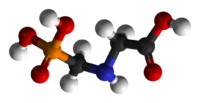
Photo from wikipedia
Abstract Glyphosate is a highly-efficient herbicide used in agriculture. With the massive use of glyphosate, many rivers and lakes have become seriously polluted. Therefore, an effective adsorbent is needed to… Click to show full abstract
Abstract Glyphosate is a highly-efficient herbicide used in agriculture. With the massive use of glyphosate, many rivers and lakes have become seriously polluted. Therefore, an effective adsorbent is needed to adsorb glyphosate from eutrophic water. In this work, two metal-organic framework (MOF) materials, MIL-101(Fe) and amine-modified MIL-101(Fe), have been synthesized by a hydrothermal method, and the adsorption kinetics, isotherms, and solution matrix effects (e.g., solution pH, coexisting ions, and ionic strength) of glyphosate binding there on have been measured. Their selectivities, adsorption properties, and adsorption mechanisms have thereby been evaluated. The results show that appending NH2 groups effectively improves the properties of MIL-101(Fe). The adsorption amount and partition coefficient (PC) of NH2-MIL-101(Fe) are 431.13 mg g−1 and 2.96 mg g−1 μM−1 at pH 4.0, respectively. In weakly acidic media, the electrostatic interaction between glyphosate and NH2-MIL-101(Fe) increases due to protonation of the NH2 groups. The terminal hydroxyl group of NH2-MIL-101(Fe) is the main substitution site of the phosphate group of glyphosate at pH 4.0 and pH 8.0. However, the terminal hydroxyl group of MIL-101(Fe) is substituted by the carboxyl group of glyphosate at pH 8.0, indicating that the NH2 groups improve the adsorptive selectivity of MIL-101(Fe) for the phosphate group. Fourier-transform infrared (FTIR) spectra and zeta potential measurements have been used to determine the main adsorption process, and a possible adsorption mechanism on MIL-101(Fe) is proposed.
Journal Title: Journal of Physics and Chemistry of Solids
Year Published: 2022
Link to full text (if available)
Share on Social Media: Sign Up to like & get
recommendations!